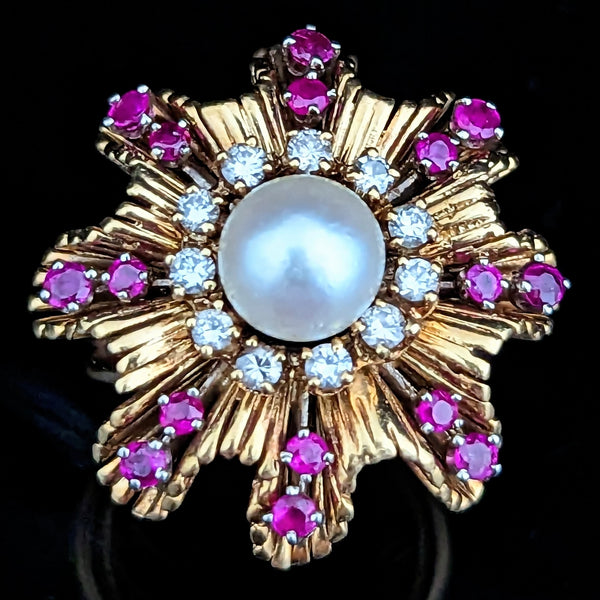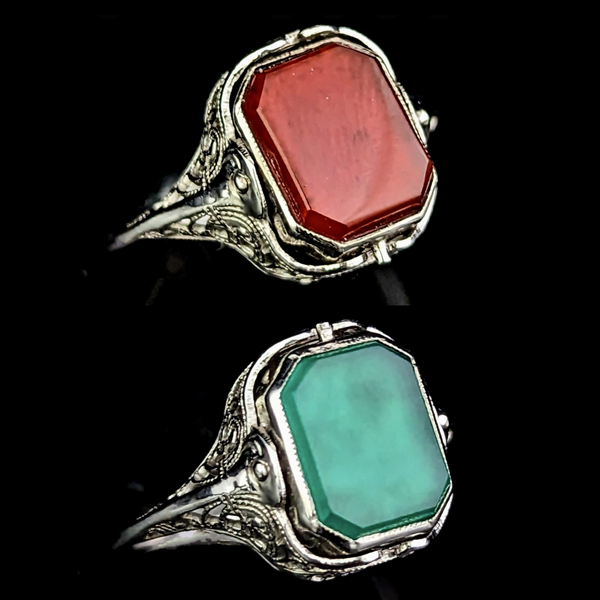The Secrets of Toi et Moi Rings: The Ultimate Symbol of Eternal Love

Unveiling the Legacy
"The 'Toi et Moi' ring, a term translation from French 'You and Me,' elegantly captures the essence of two individuals united in love and commitment. This enduring style has charmed hearts for centuries, weaving a captivating narrative that traces the evolution of romantic symbolism in jewelry. Its rich history is a testament to love's timeless allure, making it a cherished symbol for those seeking to express their deepest affections and lifelong bonds."
The late 18th and 19th Century: Romance Embodied in Jewelry
A Brief History
Osenat Auction House Listing Photo Napoleon Ring
The prominence of the Toi et Moi ring can be traced back to the end of the 18th century, a time when sentimentality and expressions of personal emotion began to find their place in jewelry. The most famous anecdote surrounding the Toi et Moi style is undoubtedly Napoleon Bonaparte’s engagement ring to Josephine de Beauharnais in 1796. This ring featured two pear-shaped stones—a sapphire and a diamond—sitting side by side. Their union on the band symbolized Napoleon and Josephine's coming together, a romantic gesture that left an indelible mark on the world of jewelry. In 2013, this very ring was auctioned for around $1,200,000 (with buyer premium), a testament to its enduring allure and historical significance.
Throughout the years, this style has been embraced and adapted by jewelers, incorporating various gemstones, settings, and designs that reflect the periods in which they were made. From the intricate settings of the Victorian era to the bold and geometric shapes of the Art Deco period, Toi et Moi rings have continually evolved while maintaining their symbolic meaning.
A Reflection of Romanticism
The Romantic movement, flourishing in the early to mid-19th century, placed a strong emphasis on emotion, individualism, and the glorification of the past. Jewelry, including Toi et Moi rings, mirrored these values, often designed to convey deep personal emotions or to serve as keepsakes of love.
Symbolism and Sentimentality
Toi et Moi rings of the 19th century were laden with symbolism. The very design of two stones set together symbolized the coming together of two lives, a physical manifestation of the union of souls. The choice of gemstones further added layers of meaning. Diamonds, with their unmatched hardness, symbolized enduring love, while other gemstones like sapphires (loyalty), rubies (passion), and pearls (purity) allowed for personalized expressions of sentiment.
The Language of Stones
The 19th century also saw the popularization of the "language of stones," where gemstones were assigned meanings and used to convey secret messages. This practice, known as acrostic jewelry, extended to Toi et Moi rings, where the choice of stones could spell out words or initials. For example, a ring with a ruby, emerald, garnet, amethyst, ruby, and diamond could spell "REGARD," a common term of endearment of the time. This level of personalized sentiment made Toi et Moi rings highly cherished tokens of affection.
A Tradition of Engagement
In the 1800s, the Toi et Moi ring also found its place as a significant symbol of engagement. This period marked a burgeoning tradition of using engagement rings to signify the promise of marriage, and the Toi et Moi style, embodying the union of two distinct individuals, became a poignant choice for many couples. The dual stones represented the coming together of two hearts and lives, making these rings a deeply meaningful selection for proposals. Reflecting the era's romantic sensibilities and the personal significance attributed to jewelry, Toi et Moi engagement rings were not only fashion statements but also powerful expressions of love and commitment. This practice underscored the cultural importance of engagement rituals in the 19th century, solidifying the Toi et Moi ring's place in the history of romantic symbols.
The 20th Century: Evolution and Celebrity Influence
As the 20th century unfolded, the fashion for Toi et Moi rings evolved, influenced by shifts in social norms, advancements in jewelry-making techniques, and the changing tastes of the public. This era saw an explosion of creativity and innovation in jewelry design, reflecting the rapid cultural shifts of the century. The Toi et Moi ring, with its inherently romantic design and symbolism of two souls becoming one, continued to captivate the imagination. The enduring appeal of these rings was further cemented by high-profile royal and celebrity engagements, which often set trends and influenced public tastes in jewelry.
.png)
Art Deco and Modernism
The early 20th century, particularly the Art Deco period (1920s and 1930s), brought about a geometric revolution in Toi et Moi ring designs. These rings began to feature more streamlined, symmetrical designs that emphasized contrast and balance, often incorporating bold color combinations and innovative cuts of gemstones. The period's fascination with modernism, technology, and progress was reflected in the clean lines and elegant simplicity of the designs, making Toi et Moi rings a favorite among the fashionable elite.
Royal and Celebrity Endorsements in the 20th Century
The 20th century saw Toi et Moi rings gain prominence through high-profile engagements, captivating both the public's heart and imagination. Notably, Jacqueline Kennedy's engagement ring from John F. Kennedy, featuring a 2.88-carat diamond and a 2.84-carat emerald set in an intricate design, symbolized the merging of two lives into a shared future. This ring became an emblem of their celebrated relationship, showcasing the timeless appeal of Toi et Moi rings as symbols of love and commitment. Similarly, Queen Margrethe of Denmark's engagement ring, crafted by Van Cleef & Arpels, featured a pair of twinned diamonds, possibly as much as six carats each, set on a diagonal on a yellow gold band with accent baguettes. Reflecting the aesthetic of the 1960s, her ring demonstrated the adaptability and enduring elegance of Toi et Moi designs. These instances of royal and celebrity engagements underscored the lasting allure of Toi et Moi rings, bridging personal significance with cultural trends and continuing to influence fashion and jewelry preferences worldwide
The Toi et Moi Ring from the 1960s Onwards
After the 1960s, the prominence of Toi et Moi rings in the mainstream jewelry market saw a decline, coinciding with a cultural shift towards minimalism and modernism in jewelry trends. This shift was significantly influenced by De Beers' "Diamonds Are Forever" campaign, which successfully ingrained the image of a single stone engagement ring into the public consciousness. The late 20th century's fashion landscape, with its emphasis on geometric shapes, bold designs, cluster, and pave rings, meant that traditional styles like the Toi et Moi experienced a period of reduced visibility. Despite this, these rings continued to be valued by collectors and enthusiasts of vintage jewelry for their romantic symbolism and unique design. It wasn't until after 2010 that Toi et Moi rings began to witness a significant resurgence, fueled by a renewed interest in personalized and meaningful jewelry, alongside the influence of modern celebrities and fashion trends. This revival has reintroduced Toi et Moi rings as a beloved choice for expressing love and commitment, proving their timeless appeal.
Resurgence and Modern Appeal
In the modern era, Toi et Moi rings have experienced a significant resurgence, driven by a desire for personalization, meaningful connections, and the influence of modern celebrities redefining style norms. This revival aligns with a broader trend towards vintage and antique jewelry, as contemporary buyers seek out pieces with unique histories and special meanings. High-profile engagements, such as Megan Fox's engagement to Machine Gun Kelly, featuring a bespoke ring with an emerald and a diamond representing their birthstones to symbolize their unique bond, and Emily Ratajkowski's distinctive two-diamond Toi et Moi ring from Sebastian Bear-McClard. These instances showcase how Toi et Moi rings continue to captivate with their timeless appeal while being perfectly adaptable to modern love stories and personal expressions of commitment.
The Timeless Symbol of Love
Through centuries of cultural shifts and evolving fashion sensibilities, Toi et Moi rings have maintained their symbolic essence and appeal as expressions of love and unity. Their enduring popularity from the early 1800s to the present day reflects the timeless human desire for jewelry that narrates a story of deep personal meaning and connection. As we look to the future, the Toi et Moi ring stands as a testament to the enduring allure of romantic symbolism in jewelry, continually captivating the hearts of those who choose to celebrate their love in a uniquely personal and stylish manner.
Also in News

The Dazzling Days of 1940s Retro Era Jewelry: Glamour Amidst Conflict
Discover the dazzling world of 1940s retro jewelry. Explore the glamorous styles, trends, and influences of this iconic era. From cocktail rings to patriotic pins, find vintage treasures at SOHOJEWELERS

Flashback to Glam: The Ultimate Guide to 1960s Cocktail Rings and Their Mesmerizing Gemstones!


.png)
.png)

.png)
.png)

.png)
.png)